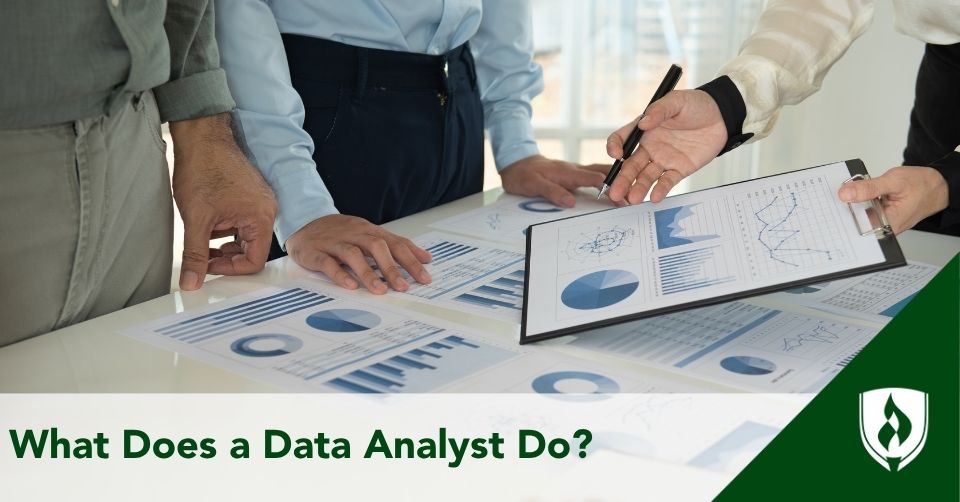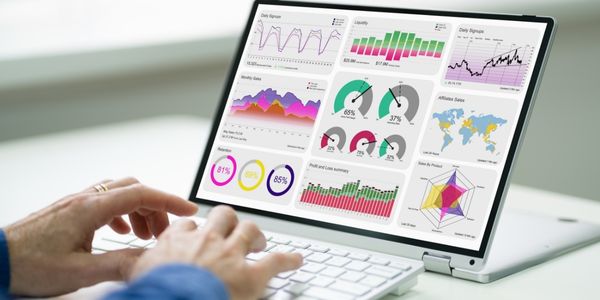What Does a Data Analyst Do?
11/25/2025

If you’re wondering what a data analyst does, the answer begins with data analysis itself: The practice1 of examining, cleaning, transforming, and modeling raw data to uncover meaningful information. Data analysts may play a crucial role1 in turning unstructured data into structured insights, helping organizations make informed decisions. By combining statistical methods, analytical skills, and technical expertise, data analysts explore existing data and provide valuable insights to guide processes like resource allocation, risk management, and operational planning.
Data analytics is at the intersection of computer science, statistical analysis, and business reasoning. While data scientists often focus on building advanced predictive models and machine learning models, data analysts typically focus1 on understanding patterns in data, identifying trends, and providing data-driven insights to support strategic business decisions.
Key Responsibilities of a Data Analyst
A data analyst role involves multiple responsibilities.2 Many data analysts work by collecting, cleaning, and organizing data to ensure data quality and data integrity. They gather data from diverse sources, perform data manipulation, and use statistical techniques such as regression analysis or predictive modeling to analyze data.
Data analysts gather2 and interpret data to create actionable insights that inform business operations, market analysis, and business intelligence processes. They often collaborate with business analysts, market research analysts, or analytics managers to translate complex datasets into understandable formats for decision-making. Data visualization software like Power BI® or Tableau® is frequently used to present findings, facilitating data storytelling that communicates trends and patterns effectively.
Data Analyst Skills and Qualifications
Data analyst skills combine3 technical skills with analytical skills. Proficiency in data manipulation, data modeling, and data visualization is typically1 a useful skill for data analysts. Many analysts are also skilled1 in data mining, statistical analysis, predictive analytics, and statistical modeling. Knowledge of machine learning, data architecture, and data structures further strengthens the ability to handle big data or complex datasets.
Strong communication skills3 are equally important. A data analyst may interpret data and convey data-driven insights in ways stakeholders can pick up on. Many data analysts typically3 hold a bachelor’s degree in computer science or a related field.
Working With Big Data
Big data refers1 to datasets that are too large or complex for traditional methods. Data analysts use specialized techniques, including machine learning models and statistical techniques, to model data and identify patterns. Handling big data requires strict data governance, careful attention to data integrity, and understanding data quality metrics.
Data analysts may work1 with both structured and unstructured data, transforming it into meaningful visualizations and insights. By applying predictive modeling or statistical methods, analysts can support critical business decisions and provide data-driven insights for long-term planning.
Business Intelligence and Data Analysis
Business intelligence and business analytics typically rely heavily on data analysis. Data analysts may play1 a role in collecting and organizing existing data, performing statistical analysis, and creating data visualizations that support data-driven decision-making. The insights generated allow organizations to identify trends, improve operational efficiency, and guide strategic business decisions.
Data analysts also work4 closely with business analysts and analytics managers to ensure that findings are actionable and presented clearly. Tools for data visualization and data storytelling help communicate findings, while statistical skills enable analysts to validate patterns and trends.
Data Visualization and Communication
Data visualization is an important aspect of data analytics. Data analysts typically create1 spreadsheets, charts, graphs, dashboards, and other visual assets to communicate data insights. Visualizations support informed decisions and ensure that data can be understood by a wide audience, including non-technical stakeholders.
By combining statistical techniques with data storytelling, analysts transform raw numbers into narratives that illustrate trends, anomalies, and relationships in data. Accuracy and clarity are critical, as actionable insights depend on trustworthy visual communication.
Staying Up-to-Date With Industry Trends
As the field of data analysis evolves, professionals learn5 from emerging tools in artificial intelligence, machine learning, and predictive analytics. Staying current with industry trends may prepare analysts to adopt new data visualization software, explore future trends, and refine technical skills.
Continuous learning, networking, and engagement with professional communities may be helpful for data analysts to maintain expertise in data governance, data modeling, and data collection techniques. This helps ensure that findings remain accurate and aligned with modern analytical standards.
Becoming a Data Analyst
To become a data analyst, individuals typically develop3 a combination of technical skills, analytical skills, and experience in data collection, data manipulation, and data visualization. Building a portfolio of data projects or participating in internships can help learners practice transforming data into actionable insights.
A data analytics career typically begins1 with understanding statistical methods, data structures, and data modeling, and may progress to roles such as senior data analyst or analytics manager. Exposure to data ethics, data integrity, and data governance is critical, especially when working with sensitive or large-scale big data sets.
The Strategic Impact of Data Analysts
A data analyst is fundamentally about providing data-driven insights that support critical business decisions. By using data analytics, statistical skills, and data visualization, analysts can typically identify patterns, measure trends, and translate findings into meaningful recommendations.
Data analysts may play a key part in helping organizations evaluate existing data, plan for future resource needs, and make informed judgments about risk management, project management, and operational efficiency. Accurate data collection, data modeling, and data storytelling ensure that data-driven insights are reliable and actionable.
Interested in exploring related career paths? Discover how data science and data analytics differ in focus, methodology, and outcomes in Data Science vs Data Analytics.
Power BI® is a registered trademark of Microsoft Corporation in the United States and/or other countries.
Tableau® is a registered trademark of Salesforce.com, Inc.
1Oracle Corporation, What Is Data Analytics?, at https://www.oracle.com/analytics/data-analytics/ (visited Oct. 31, 2025).
2Bureau of Labor Statistics, U.S. Department of Labor, Occupational Outlook Handbook, Computer and Information Systems Managers, at https://www.bls.gov/ooh/management/computer-and-information-systems-managers.htm#tab-2 (visited Oct. 31, 2025). Employment conditions may vary.
3Bureau of Labor Statistics, U.S. Department of Labor, Occupational Outlook Handbook, Computer and Information Systems Managers, at https://www.bls.gov/ooh/management/computer-and-information-systems-managers.htm#tab-4 (visited Oct. 31, 2025). Employment conditions may vary.
4Oracle Corporation, What Is Business Intelligence?, at https://www.oracle.com/what-is-business-intelligence/ (visited Oct. 31, 2025).
5Nageye, A. Y., Jimale, A. D., Abdullahi, M. O., & Ahmed, Y. A., Emerging Trends in Data Science and Big Data Analytics: A Bibliometric Analysis, SSRG International Journal of Electronics and Communication Engineering, Vol. 11, No. 5 (2024), at https://doi.org/10.14445/23488549/IJECE-V11I5P109 (visited Oct. 31, 2025).



